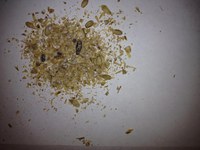Ergot Can Cause Lambing Problems
(Click the image below to view a high-resolution image that can be downloaded)
Sheep producers should have grain tested for ergot before feeding it to their animals.
“Multiple sheep producers in North Dakota have experienced losses associated with feeding grains contaminated with ergot this year,” North Dakota State University Extension Service sheep specialist Reid Redden says. “Feeding ergot-contaminated grains during late gestation reportedly has been causing premature births, severe dystocia associated with a failure to dilate, and low milk production.”
Ergot is a fungus that forms in plant seed heads, replacing the ovarian tissue of infected plants, according to Michelle Mostrom, NDSU veterinary toxicologist. The ergot body, or sclerotium, can develop in the seed ovary of cereal grains such as rye, triticale, wheat, barley and oats. The purplish-black, hard ergot sclerotia contain toxic alkaloids that are responsible for ergotism in animals.
Ergotism is a sporadic disease that can affect sheep and other animals. Ruminants such as sheep that consume rations with 0.3 to 1 percent or more sclerotia can develop gangrenous ergotism. Researchers estimate that ergot alkaloid concentrations as small as 0.2 to 0.8 milligram per kilogram, or part per million, in the total ration can produce ergotism in livestock.
Mostrom recommends that ergot body concentrations be less than 0.1 percent in the grain portion of the animals’ diet to reduce the risk of ergotism.
Ergot also can develop on the seed heads of mature grasses, including brome, timothy, quack grasses and blue grasses, so livestock producers should look for the fungus in grass hay that was baled after the grass developed seeds, Redden says.
Ergotism is a concern this year because last year’s damp spring weather favored delayed germination and growth of ergot.
Feeding grain to ewes one month prior to lambing is a very common practice in the sheep industry, Redden says. The effects of ergot are most detrimental to younger ewes because they typically are fed a higher amount of grain during late gestation to maintain optimal growth rates.
Sheep producers also often use grain screenings during this period of production. Ergot commonly is found in higher concentrations in screenings than whole grain, so testing the grain before feeding it to ewes is essential.
Contact the University of Missouri Veterinary Medical Diagnostic Lab by mail at VMDL, University Missouri, P.O. Box 6023, Columbia, Mo., 65205 or by calling (800) 862-8635 for the cost of the test and information on submitting grain or hay samples.
Although ergot is visible in livestock feeds, the alkaloids in the ergot can vary. This can explain why some producers may not have seen any detrimental effects from feeding ergot-contaminated feed in the past but severe effects have been reported this year, Redden says. In one case, tests found ergopeptine alkaloids at a rate 10 times higher than the level known to cause ergotism.
Clinical signs in sheep are necrosis, or the death of cells, at the tip of the tongue; excess drooling or salivation; diarrhea, reduction in feed intake; lameness (necrosis above the hoof wall); and decreased lambing rates and milk production, Mostrom says.
The keys to treating ergotism successfully are recognizing the clinical signs early and keeping livestock away from ergot-contaminated grains, hay, processed feeds or pastures.
“Ergot is not a new problem in North Dakota grains,” Mostrom says. “The ergot sclerotia mature at the same rate as plant seeds and can fall to the ground to overwinter and possibly germinate the following year. No-till farming practices, shallow seeding and failure to rotate crops favor ergot development in plants.”
NDSU Agriculture Communication - April 4, 2012
| Source: | Reid Redden, (701) 231-5597, reid.redden@ndsu.edu |
|---|---|
| Source: | Michelle Mostrom, (701) 231-7529, michelle.mostrom@ndsu.edu |
| Editor: | Ellen Crawford, (701) 231-5391, ellen.crawford@ndsu.edu |


